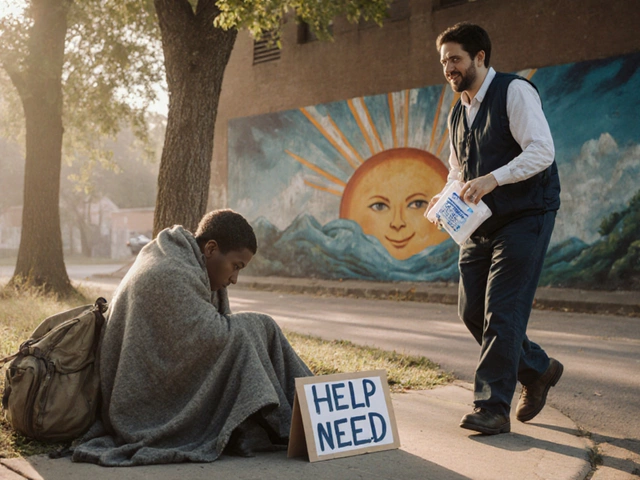Charities play an essential role in bridging gaps and addressing societal needs that may otherwise go unnoticed. They are not just about monetary support; they encompass a wide range of activities that invite participation and foster community spirit.
From bustling fundraising galas to hands-on volunteer projects, every event or initiative serves as a stepping stone towards greater societal change. Understanding these activities not only enhances their impact but also encourages diverse participation from individuals eager to make a difference.
In this article, we'll explore the different facets of charity activities, unraveling the opportunities they present for both participants and beneficiaries. Whether you're an experienced volunteer or a curious newcomer, there's something here to inspire your journey of giving back.
Fundraising Events
Organizing fundraising events is an artful endeavor that serves as the backbone of many charity organizations. These events not only raise much-needed funds but also elevate the profile of various causes, drawing attention and support from potential donors and dedicated volunteers alike. A well-planned fundraising event can ignite a sense of community and create lasting impacts both financially and socially. The heart of a successful event often lies in its creativity and ability to engage the target audience genuinely.
One of the most widely recognized methods is the charity gala, a formal event that combines dining, entertainment, and auctions. These gatherings are ideal platforms for raising substantial amounts, attracting philanthropists and companies willing to donate considerable sums in exchange for brand visibility. However, such sophistication requires meticulous planning, from securing a venue to organizing the flow of events. Alternatively, more casual settings such as fun runs or bake sales draw in mass participation through a more laid-back atmosphere. Fun runs have gained traction with their dual benefit of promoting fitness and community spirit, reportedly contributing millions to charitable causes worldwide, according to a report by Run for Charity.
“Fundraising events offer more than monetary support; they cultivate hope, camaraderie, and resilience,” says Emma Saunders of the Help Foundation.
Communities are increasingly turning to themed occasions like trivia nights, art exhibitions, or pop-up shops to invigorate potential contributors. These themed events leverage specific interests and hobbies, thereby reaching unique audiences who might not typically engage with conventional charity events. By investing in varied event types, charities are not only raising funds but also engaging donors on a personal level, potentially paving the way for long-term relationships.
With the rise of digital platforms, virtual fundraising has carved out its own niche. Utilizing social media to host online auctions or crowdfunding campaigns expands reach beyond geographical barriers and taps into a global pool of donors. The adaptability of virtual events means they can be quickly organized and widely shared. Technology also provides tools for online engagement, making it easier to track participant interest and donations in real-time, enhancing event outcomes efficiently.
Below is a comparison of traditional and virtual fundraising success rates based on recent surveys:
| Event Type | Average Raised |
|---|---|
| Traditional Galas | $50,000+ |
| Virtual Campaigns | $20,000+ |
While planning a fundraising event, one must consider the demographic, interests of the participants, and the specific cause it supports. A balance of excitement and purpose often promises the best return. Thus, these events, whether grand or simple, virtual or physical, contribute immensely to the backbone of any charity. They are indispensable to fostering a culture of giving, uniting people under a shared banner of goodwill.

Volunteer Opportunities
Engaging in volunteer activities is one of the most profound ways individuals can contribute to society, offering their time and skills towards causes they believe in. Volunteering provides an array of opportunities that cater to different interests, skills, and availability. Whether it's helping at a local food bank, participating in environmental clean-up drives, or organizing educational programs, the scope is extensive and impactful. Volunteering not only benefits communities but also offers personal growth for volunteers, bringing a sense of purpose and fulfillment.
One noteworthy area is assistance in disaster relief, where volunteers can make an enormous difference. Organizations like the Red Cross and FEMA rely heavily on volunteers to help communities recover from disasters. This could involve anything from distributing food and supplies to helping rebuild homes and infrastructure. The training these volunteers receive can also be a valuable skill set that enhances their personal and professional lives. According to a study by the Corporation for National and Community Service, those who regularly engage in volunteering are not only likely to find it beneficial for their health but also for forming meaningful social connections.
Consider the impact of volunteering on education-focused initiatives. Programs such as tutoring, mentoring, and after-school activities aim to uplift and educate youth by providing supplementary learning environments. Volunteers can share their expertise and help students not only improve academically but also build confidence and resilience. Projects like these inspire future leaders and innovators by fostering an environment of support and encouragement. They demonstrate that the power of volunteering extends beyond immediate relief or aid; it builds the very foundation of hope and future potential.
In addition to these, environmental volunteering has gained traction, offering opportunities for individuals to address pressing ecological issues. This includes tree planting, wildlife conservation, and eco-awareness campaigns, tasks that draw attention to and mitigate the environmental challenges we face. By volunteering in these areas, individuals can directly contribute to the preservation and restoration of natural habitats while educating others about sustainable practices. According to the International Union for Conservation of Nature (IUCN), grassroots efforts such as these are vital in achieving global conservation goals.
"The best way to find yourself is to lose yourself in the service of others." – Mahatma GandhiVolunteering is a gateway to not only helping others but also discovering personal strengths and potential. As we continue to recognize the importance of collective effort, volunteer opportunities remain a cornerstone for community building and hearts bonding in shared endeavors. This participatory spirit not only strengthens the social fabric but also inspires others to join in and extend their support, creating a ripple effect of kindness and change.

Community Outreach
Community outreach lies at the heart of many charity events, acting as a fundamental pillar for fostering connections and driving positive change at a local level. This aspect of charitable work focuses on building relationships within communities, identifying their unique needs, and tailoring support accordingly. Through outreach activities, charities aim to raise awareness, engage local stakeholders, and ultimately create a more compassionate and closely-knit society.
A well-organized community outreach program often involves a variety of initiatives. These may include organizing workshops for skill development, or perhaps establishing support groups where individuals can share experiences and lend emotional support. What’s crucial here is the genuine commitment to understanding the community’s dynamics and effectively responding with meaningful solutions. The key lies in collaboration and active participation from both the organization and the residents.
"Community outreach is not just about providing services; it's about delivering hope," says Jane Goodall, renowned ethologist and conservationist. "When people feel understood and supported, they’re empowered to contribute and transform their surroundings."
Moreover, community outreach sometimes extends to educational initiatives aimed at increasing awareness about pressing issues like health, environmental challenges, or social justice. Whether it's a campaign addressing the importance of mental health or an information session on sustainable practices, these educational efforts are crucial. They not only solve immediate problems but also equip individuals with the knowledge to tackle future challenges independently.
Charities often leverage the power of collaboration during community outreach exercises. Partnering with local businesses, schools, or governmental entities can amplify the impact. This synergy ensures a diversification of resources, making outreach efforts more sustainable in the long run. Different sectors bring in distinct strengths, enabling comprehensive solutions that might otherwise remain elusive.
| Aspect | Impact |
|---|---|
| Youth Engagement Programs | Improves educational outcomes and life skills |
| Health Awareness Campaigns | Reduces community health crises |
| Environmental Cleanup Drives | Promotes ecological balance and awareness |
It’s important to note that community outreach is not a one-time event; instead, it is an ongoing commitment. Regular feedback loops, assessments, and the flexibility to adapt according to shifting needs are vital components. Only through persistent effort and sensitive handling can a community truly rise and witness the transformative effects of charity at its doorstep.

Educational Initiatives
Educational initiatives within charitable organizations are a cornerstone for driving long-term societal change. These programs often focus on enhancing knowledge and skills of individuals, especially in underserved communities. By providing access to education and creating opportunities for personal and professional growth, charities can transform lives and empower future generations. Not only do these initiatives bridge educational gaps, but they also instill a passion for lifelong learning.
Many charities collaborate with local schools and educational institutions to offer after-school programs, mentorship opportunities, and scholarship schemes that help students achieve their full potential. For instance, organizations like UNICEF have been known to tirelessly promote children's education across the globe, ensuring that educational opportunities reach even the most remote areas. Through their work, they have illuminated the critical link between education and a prosperous future. A significant statistic to consider is UNESCO's report revealing that every additional year of schooling can potentially increase a person's income by up to 10%, emphasizing the profound impact of such initiatives.
Aside from conventional education, many charities focus on vocational training aimed at empowering individuals with the skills required to secure employment in various industries. This kind of training is vital, especially in economically challenged communities where access to formal employment might be limited. By teaching practical skills such as carpentry, tailoring, or IT, charities equip individuals with tools for self-reliance. An inspirational quote in this regard comes from Malala Yousafzai, a tireless advocate for girls' education, who said,
"One child, one teacher, one book, and one pen can change the world."Her words resonate deeply within the mission statements of numerous educational programs, motivating change-makers and learners alike.
Charities also innovate by incorporating technology into educational initiatives. The rise of online learning platforms allows these organizations to expand their reach, bringing high-quality educational resources to those who lack access to traditional schooling. Initiatives that blend technology with education not only draw the tech-savvy younger generation but also open new avenues for adults seeking to update their skills. This blend of education and technology addresses a crucial issue; a study by the World Bank found that about 87% of low-income country residents are not equipped with digital skills necessary for sustainable jobs, thus highlighting the importance of these progressive efforts.
Moreover, community-based learning programs are fostering environments where learning is encouraged beyond the classroom. Through workshops, seminars, and discussion forums, these initiatives enable participants to engage in diverse subjects, fostering a culture of shared knowledge and curiosity. Programs championed by non-profits like The World Literacy Foundation have successfully utilized this model, promoting not just literacy but also a love for reading and learning. These programs often lead to measurable improvements in literacy rates, evidenced by countless success stories of communities lifted out of poverty through education.
To summarize, educational initiatives undertaken by charities make a decisive impact by equipping participants with the necessary tools and resources to break free from the cycle of poverty. In doing so, they lay the groundwork for a more educated, skilled, and resilient population poised to contribute meaningfully to society. As the digital age continues to transform how the world learns, these initiatives adapt and innovate, ensuring that education remains accessible and relevant to all.





